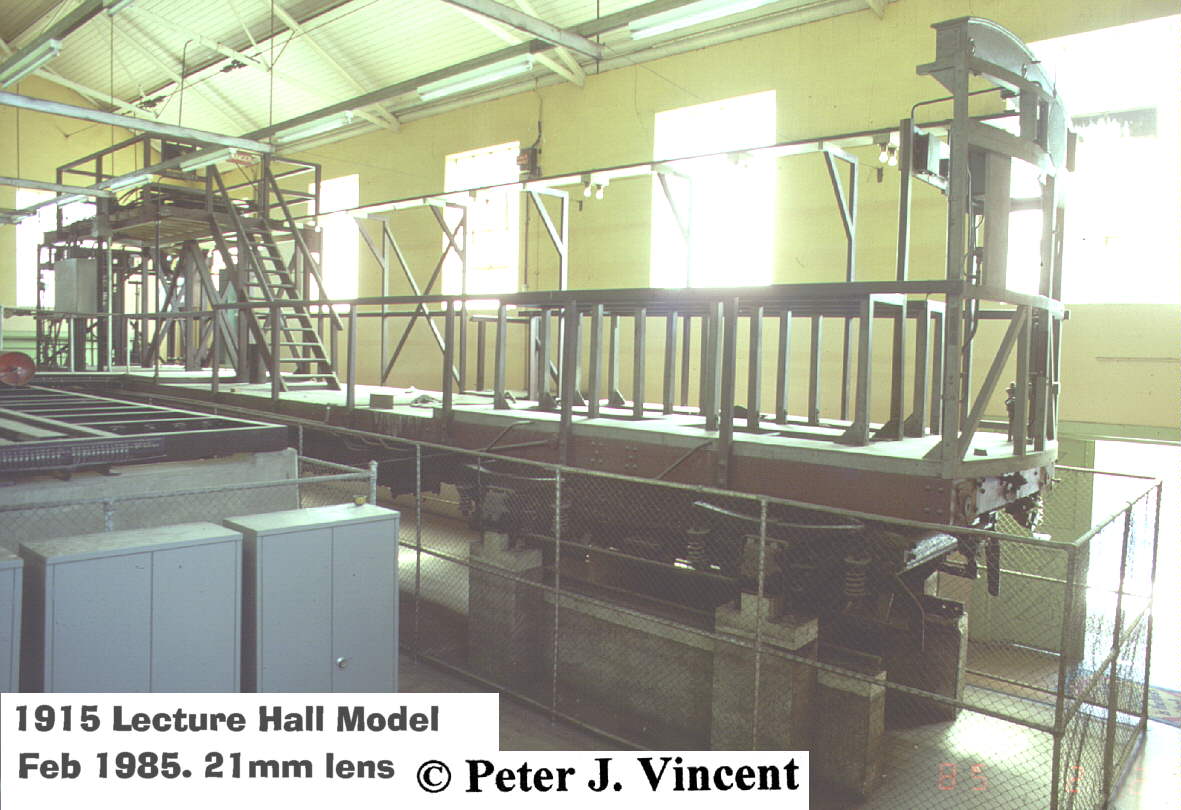

These vehicles were never part of any records associated with the Rolling Stock Register. They were to provide static training for suburban train drivers. They were useful for equipment location and fault finding where certain procedures are implemented to track down and overcome problems in order to keep the train moving.
The main 'model' was closely associated to the start of suburban electrification in 1919 and the Swing Door _M__ cars.
The second 'model' was introduced with the Harris trains of 1956.
The main Lecture Hall Model was a fully equipped swing door M underframe with sufficient wooden superstructure to support the electrical fittings. The vehicle included an operating pantograph.
The vehicle was built in England during 1915 and was the test car for the underframe arrangement for the suburban electric motor cars. The electrical equipment on it was fitted out at Rugby by the General Electric Company. After inspection by the consulting engineers, Mertz and McLellan, the car was shipped to Australia and arrived June 1915.
Economic efforts of World War I stopped the electrification project until 1918. The Lecture Hall building was constructed by 1919. The bogies for the model were installed on concrete pillars. The underframe was then mounted onto the bogies. The wooden superstructure was then built. The traction motors were open to show the workings.
Along the north side of the model, a rope system was used to link all axles. A rope loop on each bogie went around an axle pulley. The innermost axles were then connected by another rope loop. The rope was about 2" / 50mm diameter. This system was attached to the model from the start and was used to ensure that all axles rotated in the same direction.
The pantograph on the roof made contact with a short section of overhead wire. The wire was connected to the Batman Avenue tramways power supply of 600VDC.
The model was fitted with a fully operational _M__ cab at one end and a _D__ cab at the other. This even included a destination roll. By 1975 the roll had been removed for preservation; owner traced. The original destination reference plate was still visible.
The original plan was for two models: M car and a _D__ car. The model was revised during construction to include a D car end.
The model was used for instructional purposes between 1919 and about 1980. Crews were taught controller operation, switch and fuse locations, and fault finding. Even the Westinghouse brake equipment worked, from compressor, main reservoir to drivers brake valve and brake equipment to the wheels.
The main functon of the model was to train drivers prior to the start of electric train running. Once sufficient trains were in service, the drivers were trained on operating sets. The Lecture Hall Model then served as an introduction to electric train running and the main components involved.
With the introduction of the second lecture hall model for 'Harris' trains, a switching circuit was provided. The 600VDC was retained for the original model. A 1500VDC supply was provided for the 'Harris' model.
Given that the model was used about five times per year the 'distance' travelled would be no more than about three miles per year; about two hundred miles in total. This would fairly indicate that the original traction motors were still fitted!
The last training on the model was by about August 1980. The vehicle was dismantled in August/September 1985. The superstructure destroyed, the underframe cutup and the concrete pillars jack hammered away. The bogies and electrical equipment were salvaged by members of Elecrail for their restoration projects.
In about 1955, a Harris _M__ Lecture Hall Model was added.
This model represented the new technology of the 1940's being placed into service. An operating cab was placed at one end with all switch gear visible. The underframe was placed onto concrete pillars to make the undergear workings easy to view.
The intersting feature of this model was that it had all the switchgear and circuitry for the Harris M car but was not fitted with bogies or traction motors. Operation of the 1500VDC switch previously mentioned allowed the controls of the Harris model to 'drive' the traction motors of the original model.
During September 1985, this model was also cut up for scrap and removed.
References: Public Records Office, Des Jowett, G.F. Seymour
File c160v19 compiled by Peter J. Vincent, updated 16/7/2007